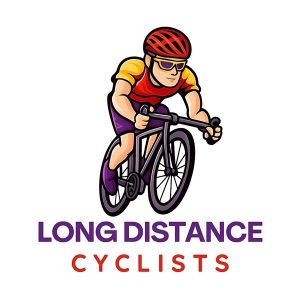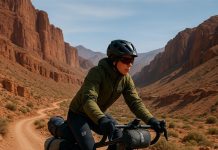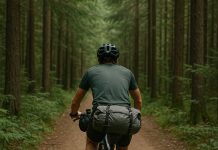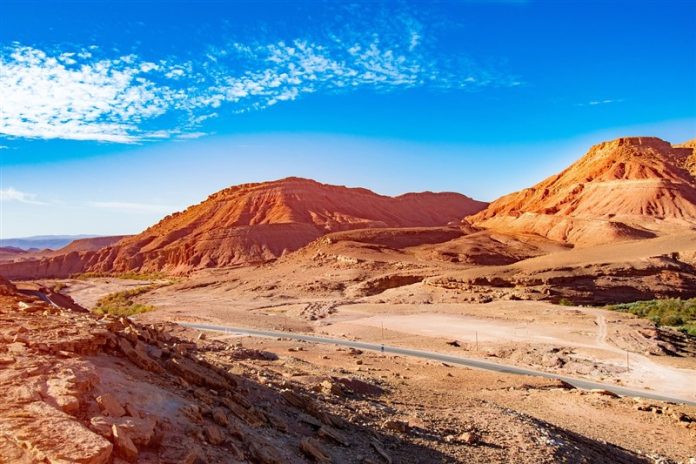The Atlas Mountains in Africa are a spectacular, varied, and challenging region for cycling. For riders seeking dramatic scenery, demanding climbs, ancient kasbahs, and a taste of Berber culture, the High and Middle Atlas offer unforgettable routes—on tarmac and hard-packed tracks. This guide covers practical planning, airports and access, recommended routes, bike hire and transport options, organised tour companies, route choices, bike and gear recommendations, accommodation, hazards, and essential tips to get you on the road with confidence.
Why cycle the Atlas Mountains?
Cycling the Atlas delivers a mix of remote landscapes, gradual but steep alpine-style climbs, and unique cultural stops. Riders can experience high mountain passes, red-rock gorges, palm-filled valleys and historic caravan routes. For credit-card touring (lightweight, accommodation-based trips) and technical gravel mixes, the Atlas rewards preparation, flexibility and respect for local conditions.
Airports and how to get there
Flying in from Europe or beyond, these airports are the most convenient gateways for Atlas cycling trips:
Major Airports
- Marrakech Menara (RAK) – Most popular entry point for Atlas trips. Marrakech is close to the High Atlas and provides abundant bike hire, guides and transport options.
- Ouarzazate Airport (OZZ) – Closest to the south-eastern Atlas gateway and useful for access to Aït Benhaddou and the Dades/Todra gorges.
- Casablanca Mohammed V (CMN) – Major international hub; good for onward domestic connections.
- Agadir-Al Massira (AGA) – Useful for Western High Atlas coastal approaches.
- Fès–Saïs (FEZ) – North-eastern approaches to Middle Atlas routes.
- Errachidia (ERH) – Regional airport serving routes east of the High Atlas (Todra, Dades).
From Marrakech, most riders head south-east, climbing Tizi n’Test or Tizi n’Tichka into the High Atlas. Direct transfers by private vehicle to start points are easy to arrange and common with tour operators.
Key routes and highlights
The Atlas offers many route permutations. Below is a set of commonly ridden itineraries that suit a range of abilities.
High Atlas Classic (Marrakech → Ouarzazate → Dades → Todra → Zagora)
This route moves from Marrakech across the High Atlas via Tizi n’Tichka, then down to the southern valleys. Expect long ascents, technical descents, and spectacular gorges.
- Distance (typical): 350–450 km, depending on variants
- Profile: Big climbs (Tizi n’Tichka ~2260 m), high-altitude passes, mixed tarmac and hard-packed roads
Aït Benhaddou & Ouarzazate Loop
A shorter cultural loop that includes the UNESCO kasbah and desert-edge landscapes; ideal for 2–4 day trips.
- Distance: 100–220 km
- Profile: Moderate climbs with scenic valley riding
Todra & Dades Gorges Route
Focuses on the deep gorges, palm-lined canyon roads, and dramatic rock faces. Good for riders who want memorable scenery and short but steep climbs.
- Distance: 150–300 km depending on loop
- Profile: Short, sharp climbs; protected valley roads; hot summer temps
Ifrane & Middle Atlas (Northern routes)
A cooler, forested alternative in the Middle Atlas with pine forests and mountain lakes—popular in spring and autumn.
- Distance: Varies
- Profile: Rolling climbs, moderate altitude, fewer desert heat challenges
Bike hire and transport companies
Below is a practical table of categories you should look for. (Local company details change; use these as search terms and confirm availability in advance.)
| Type | Example provider names (search locally) | What to expect |
|---|---|---|
| Bike hire (road/gravel/e-mtb) | Atlas Bike Hire (Marrakech), Ride Morocco, Ouarzazate Bike Rental | Quality touring or gravel bikes, sometimes limited framesizes—book ahead |
| Bike transport/van transfers | Quality touring or gravel bikes, sometimes limited frame sizes—book ahead | Transfers between Marrakech–Ouarzazate–Todra; bike boxes sometimes required |
| Airport pickups | Many hire companies; local taxis & private transfers | Prebooked vehicle with bike racks or in-van packing |
Note: Company names above are representative. Verify current operators and read reviews; smaller shops may only appear once a season.
Organised tour companies
Riding with an organised provider simplifies logistics and ensures local knowledge. Below is a table of types of providers to consider and services they commonly include.
| Company type | Services typically offered | Best for |
|---|---|---|
| Local cycling operators | Bike hire, guided rides, luggage transfers, support vehicle | Riders who want local expertise and flexible itineraries |
| International tour operators | Package tours, hotels, guides, flights or transfers included | Travellers who prefer turnkey trips and guaranteed dates |
| Adventure outfitters | Multi-day bikepacking or mixed-terrain expeditions | Experienced riders seeking backcountry routes and remote camps |
Some established tour names to search: Morocco Cycling Tours, Ride Morocco, and larger European operators that run Morocco departures. Check reviews and what’s included—bike quality varies widely.
Route details and sample day plans
Below are suggested stages for the High Atlas Classic, aimed at credit-card touring (light luggage, hotels/guesthouses).
Sample 6-day High Atlas Classic (Moderate to Challenging)
Day 1 – Marrakech → Asni → Imlil (≈ 60–90 km): Warm up ride through palm plains and small villages; optional short detour to Imlil, gateway to mountain trails.
Day 2 – Imlil → Tizi n’Tichka (tackle the climb, stop at Ait Ben Haddou) (≈ 120 km): Long climb to the pass; stop at historic kasbahs.
Day 3 – Tizi n’Tichka → Ouarzazate (≈ 60–80 km): Descend into valley roads and cultural stops.
Day 4 – Ouarzazate → Dades Gorge (≈ 120 km): Mixed roads with valley riding; smaller climbs.
Day 5 – Dades → Todra Gorge → Tinghir (≈ 80–110 km): Explore gorges and palm-lined canyon roads.
Day 6 – Tinghir → Zagora (optional desert tack-on) or return to Marrakech by transfer.
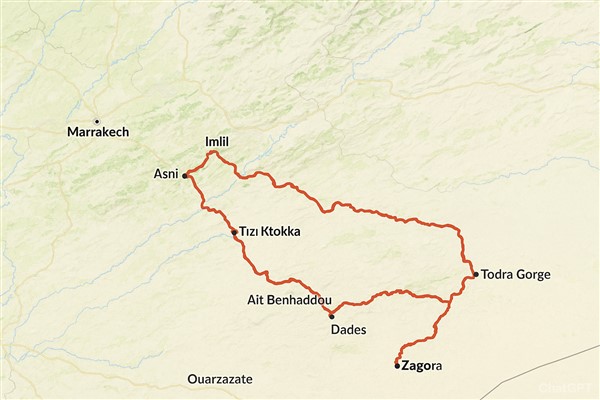
Adapt daily distances to rider fitness and local weather. Summer heat can make longer stages unpleasant; spring and autumn are often ideal.
Best type of bike and gearing
Choosing the right machine depends on surface mix and personal preference. The Atlas suits versatile bikes that can handle tarmac, rougher paved surfaces and light dirt.
Recommended bikes
- All-road/gravel bike – A 700×35–45 mm tyre clearance, drop bars, and a comfortable geometry is ideal. Tubeless-ready wheels help manage punctures.
- Light touring/endurance road bike – If you plan mostly paved touring and want speed, choose 32–38 mm tyres.
- Hardtail mountain bike – For off-road exploration and tracks, a modern hardtail with 29er wheels provides confidence; consider drop-bar conversions if long road sections are involved.
- e-Bike (optional) – Useful for riders who want assistance on long climbs; check battery range and legal/regulatory limits.
Gearing advice
Low gearing is crucial for steep Atlas passes. Aim for:
- 2x drivetrain with compact or sub-compact chainrings (e.g., 46/30 or 48/32) and an 11–34 or 11–36 cassette
- 1x gravel setups with a large-range 10–42 or 10–46 cassette are an excellent simplified option
- If you expect to carry heavier luggage or are less fit, consider even lower ratios (e.g., 30T chainring with 11–40 cassette equivalents).
Essential gear checklist
Pack light for credit card touring, but bring quality essentials.
Must-haves
- Lightweight frame bag or seatpack for tools, spare tube, and passport
- Mini-pump or CO₂, tubeless repair kit
- Reliable lights and a headlamp for early starts
- Multi-tool, spare chain links, brake pads
- High-SPF sun protection, hydration system, electrolyte powder
- Layers: breathable base layer, windbreaker, light thermal for high passes
- Good GPS (Komoot, RideWithGPS, Garmin) and paper map backup
- Cash in local currency (smaller towns may not accept cards)
Optional but highly recommended
- Dynamo hub or lightweight power bank for charging phones/GPS on multi-day rides
- Lightweight lock and discreet storage method for bike security overnight
- Local SIM card with data for navigation and calls
Accommodation options
Accommodation ranges from riads and guesthouses to remote bivouacs.
Hotels and Riads
- Riads in Marrakech are charming, centrally located, and provide secure bike storage. In mountain towns you’ll find guesthouses or simple hotels—book ahead in high season.
- Ouarzazate and major towns: full-service hotels, western-style comforts, and bike-friendly staff.
Camping and wild camping
- Wild camping is possible in the more remote Atlas valleys, but check local regulations and be respectful: avoid farming land, seek landowner permission when in doubt, and practice Leave No Trace.
- Organised camping: Some local tour companies offer campsites or arrange desert bivouacs with full logistics and caterers—an excellent option if you want one setup without packing a tent.
For credit-card touring, most riders book hotels each night, though carrying a lightweight bivvy or minimal tent adds flexibility.
Food, water and local supplies
Markets and small shops provide fresh bread, fruits, bottled water and simple cooked meals. Plan for stretches with limited services—carry an extra bottle and a basic snack stash for long stages. Mountain villages typically have cafes, tea houses and local eateries; try to buy food locally to support communities.
Safety, hazards and local considerations
Cycling in the Atlas is rewarding but not without risks. Awareness and preparation reduce problems.
Road and traffic hazards
- Road surfaces vary: Expect sudden patching, loose gravel, or potholes on mountain descents.
- Heavy vehicles and buses: Large trucks use main passes; on narrow roads, give space and be visible.
- Night riding: Avoid if possible—unlit roads and animals on the road are hazards.
- Animals & herders: Sheep, goats and donkey caravans can appear on roads, especially in valleys.
Weather and temperature
- Summer temperatures can exceed 35–40°C low in the valleys; high passes can be cool even in summer and snow is possible in winter.
- Wind: Crosswinds can be strong on exposed sections—plan accordingly.
Health and medical
- Carry a basic first aid kit and any prescription medication with you.
- Pharmacies are available in towns, but for serious injuries, evacuation to Marrakech or Ouarzazate may be necessary.
Local customs and cultural respect
- Dress and behave respectfully, especially in rural areas.
- Ask before photographing people; small gifts or local courtesy are appreciated.
- Language: Moroccan Arabic and Tamazight (Berber) are common; French is useful. Learn a few greetings—locals appreciate effort.
Table – Example bike hire & transport (verify availability)
| Service | What they provide | Notes |
|---|---|---|
| Atlas Bike Hire (Marrakech) | Gravel and road bikes, helmets, basic tools | Book well ahead for peak season |
| Ride Morocco | Guided day rides, multi-day packages, bike hire | Offers airport transfers and support |
| Ouarzazate Bike Rental | Hardtails & trekking bikes for local exploration | Smaller stock—best to pre-arrange |
Table – Example organised tour companies (verify independently)
| Operator | Typical package | Highlights |
|---|---|---|
| Morocco Cycling Tours | 4–10 day guided tours, hotels, transfers, luggage | Local guiding expertise and equipment options |
| Ride Morocco | 4–10-day guided tours, hotels, transfers, luggage | Flexible dates, local support vehicle options |
| Adventure Atlas (example local outfitter) | Bikepacking expeditions & logistics | Remote camps, bespoke itineraries |
Practical tips for planning
- Best season: Spring (March–May) and autumn (September–November) for milder temperatures and stable weather. Late winter can be snowy at high elevations.
- Book essentials: During high season (spring, autumn), reserve accommodation and hire bikes in advance.
- Insurance: Ensure your travel insurance covers cycle touring and medical evacuation.
- Money & cards: Carry cash for small towns; major hotels often accept cards.
Cultural experiences and side trips
- Visit Aït Benhaddou (UNESCO kasbah) for film history and architecture.
- Explore local souks for spices, carpets, and Berber handicrafts.
- Plan a rest day with a guided cultural visit or a cooking experience in a riad.
Final thoughts
Cycling the Atlas Mountains is an exceptional adventure that rewards riders with dramatic landscapes, challenging climbs, and cultural richness. Whether you choose a self-guided credit-card tour on a gravel bike, a fully supported guided expedition or enter the Atlas Mountain Race, thorough preparation will make the experience enjoyable and safe. Respect local customs, travel light when possible, and remember that flexibility—adjusting daily distances and plans for weather or road conditions—will keep the trip memorable for all the right reasons.
